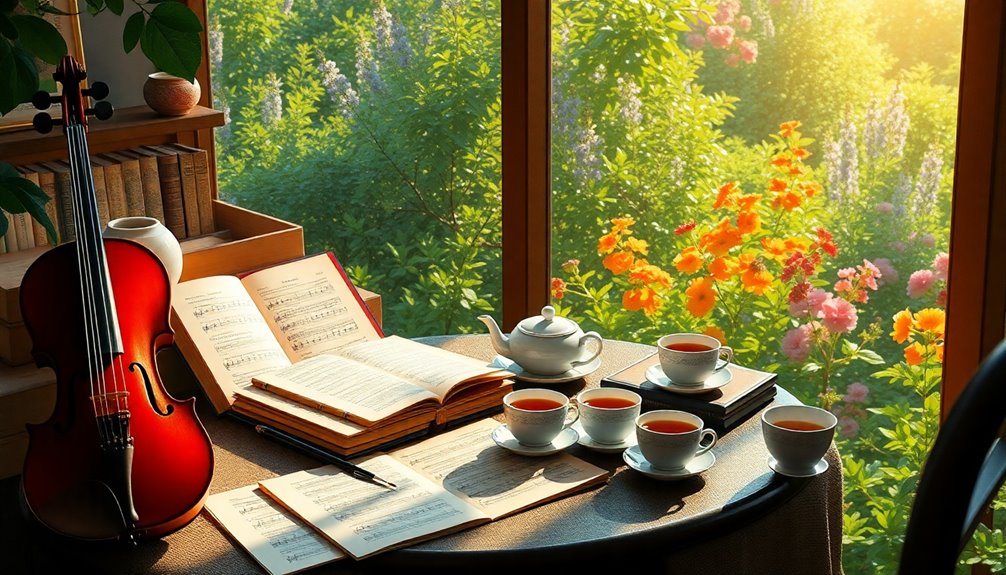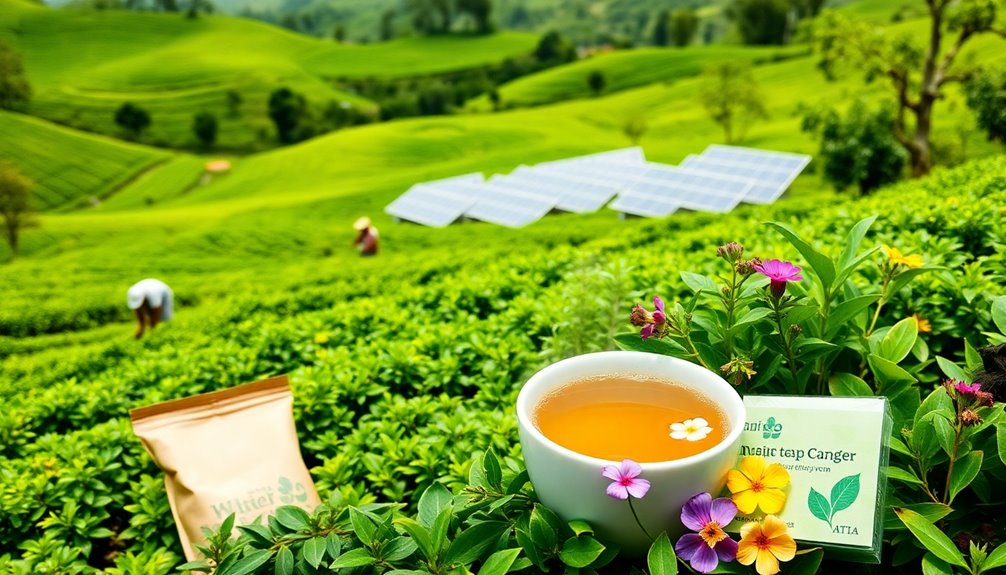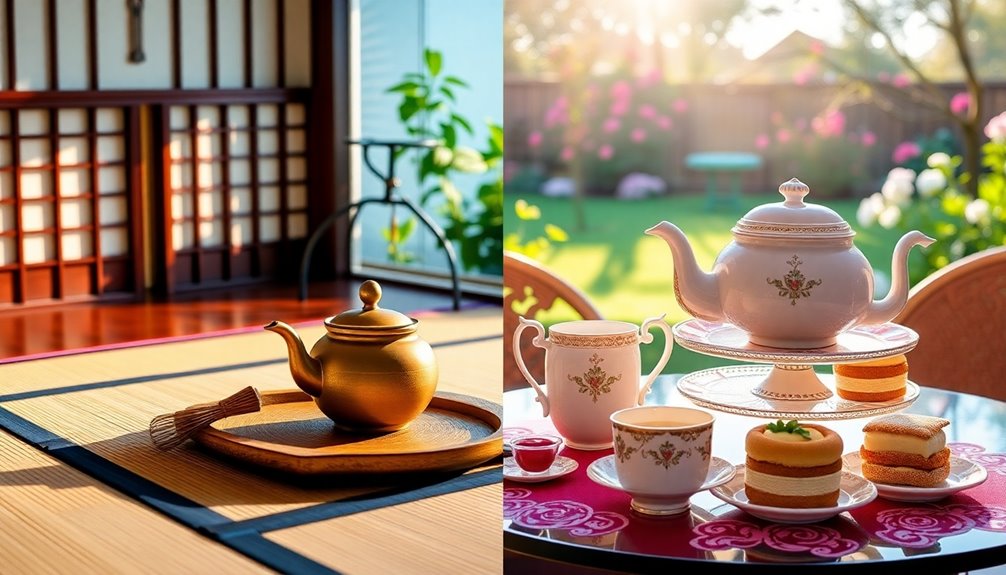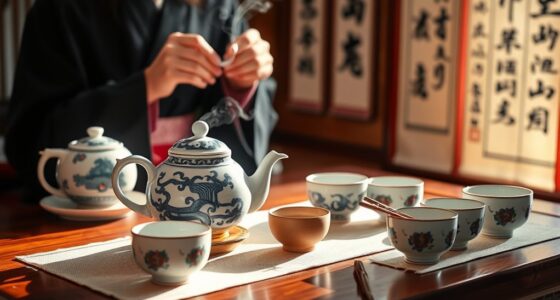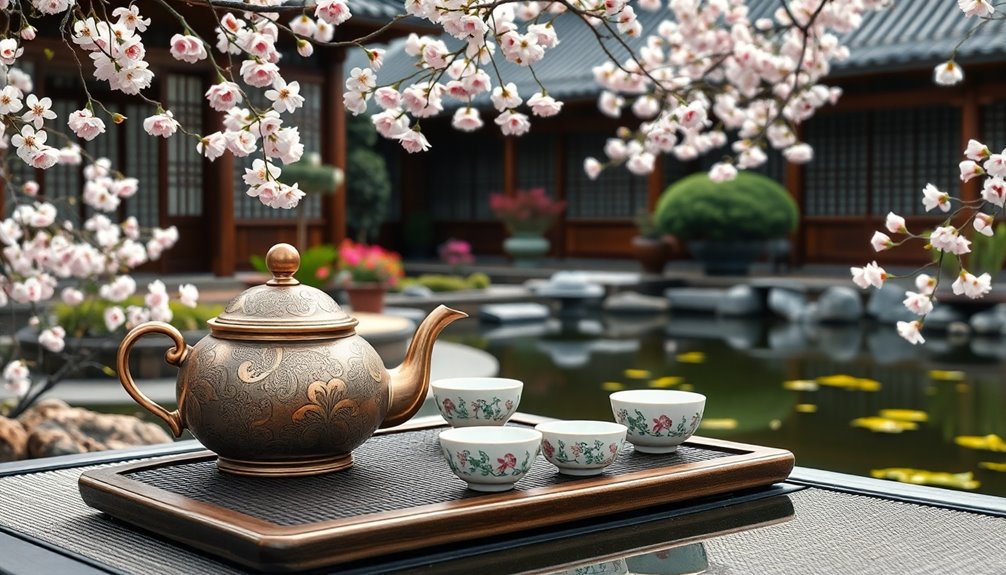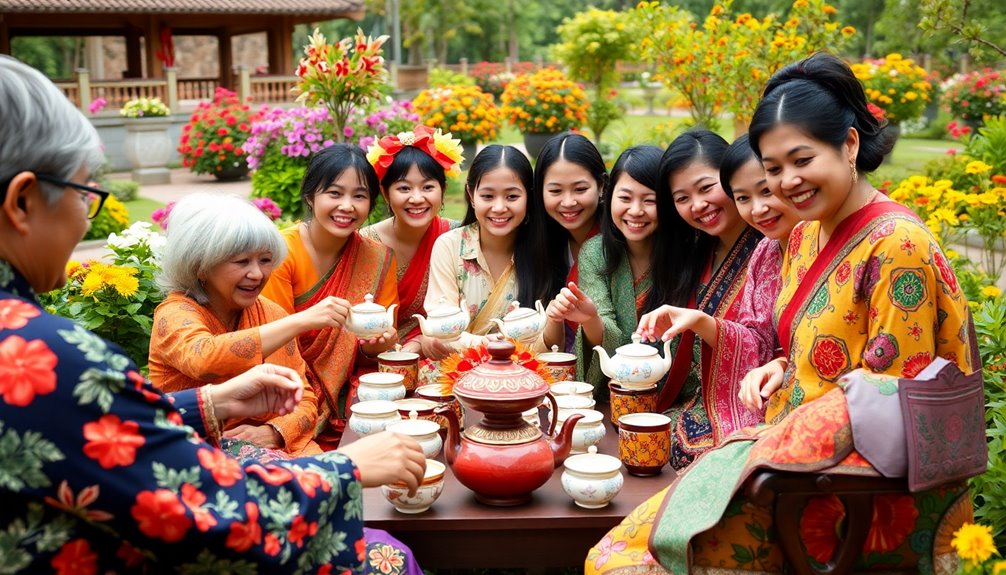Tea's presence in art, music, and literature shines brightly across cultures. It's not just a drink; it's a way to connect. In paintings, like those by Mary Cassatt, tea parties display elegance and tradition. Music, too, captures tea's spirit, with pieces like "Tea for Two" celebrating joy and togetherness. In literature, tea symbolizes refinement and thoughtfulness, often framing social scenes. Remember, while enjoying tea's beauty, it's important to respect its cultural origins. From art to melodies, tea enriches our experiences, and there's so much more to explore about this fascinating topic!
Key Takeaways
- Tea serves as a prominent theme in literature, symbolizing refinement and contemplation in various cultures.
- Visual arts frequently depict tea rituals, showcasing its cultural significance through still life paintings and elegant ceremonies.
- Musical compositions, like "Tea for Two," highlight tea's role in social interactions and communal gatherings across different genres.
- Culinary arts creatively incorporate tea, exemplified by unique dishes like green tea ice cream and Earl Grey chocolates.
- Cultural appropriation can misrepresent tea traditions, emphasizing the need for respect and authenticity in tea art practices.
Introduction
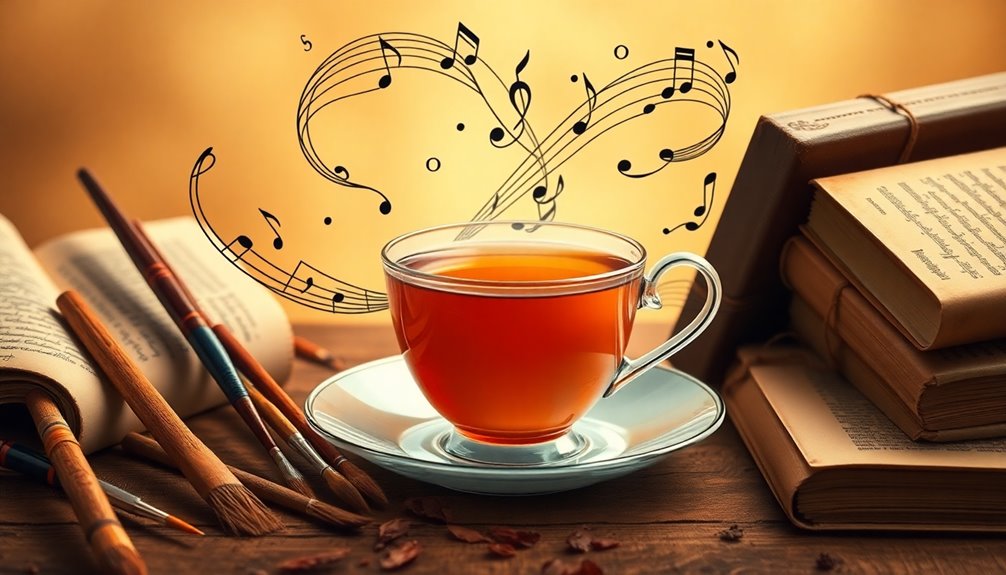
Tea has woven itself into the fabric of cultures around the world, serving not just as a beverage but as a source of artistic inspiration and social connection. When you think about tea culture, it's fascinating to see how it influences art, music, and literature. For centuries, tea has been more than just something to sip. It's sparked creativity and brought people together.
In the 17th century, tea parties became popular in Europe, transforming social gatherings into lively events. Artists like Mary Cassatt captured these moments beautifully, showing how tea and art intertwine.
In Asia, the rituals of brewing tea are seen as an art form in themselves, with unique teapot designs reflecting deep cultural traditions.
You'll also find that literature often features tea, symbolizing refinement and contemplation. Japanese poetry, for example, uses tea to express complex emotions and human experiences.
Plus, the culinary arts have embraced tea, creating delicious treats like green tea ice cream, which highlights tea's versatility.
Cultural Significance of Tea

Across cultures, the significance of tea goes far beyond its role as a refreshing drink. Tea has been a part of social rituals for centuries, from Japan's serene tea ceremonies to the elegant afternoon tea in England that began in the 17th century. These traditions show how tea fosters connections and conversations among people, making it a vital part of daily life.
In Turkey, for example, çai acts as a social lubricant, helping to build relationships within communities. The visual arts also capture tea's importance, where still life paintings and portrayals of tea ceremonies reveal its role in everyday life and changing societal norms.
Celebrating International Tea Day on May 21st highlights tea's cultural impact while promoting sustainable practices.
Plus, you can't forget the health benefits! Tea is known for its antioxidants and calming properties, making it a great choice for a refreshing break. Additionally, various types of herbal teas, such as chamomile and peppermint, offer unique flavors and potential health advantages, enhancing the overall tea experience.
Tea's Influence on Artistic Expression
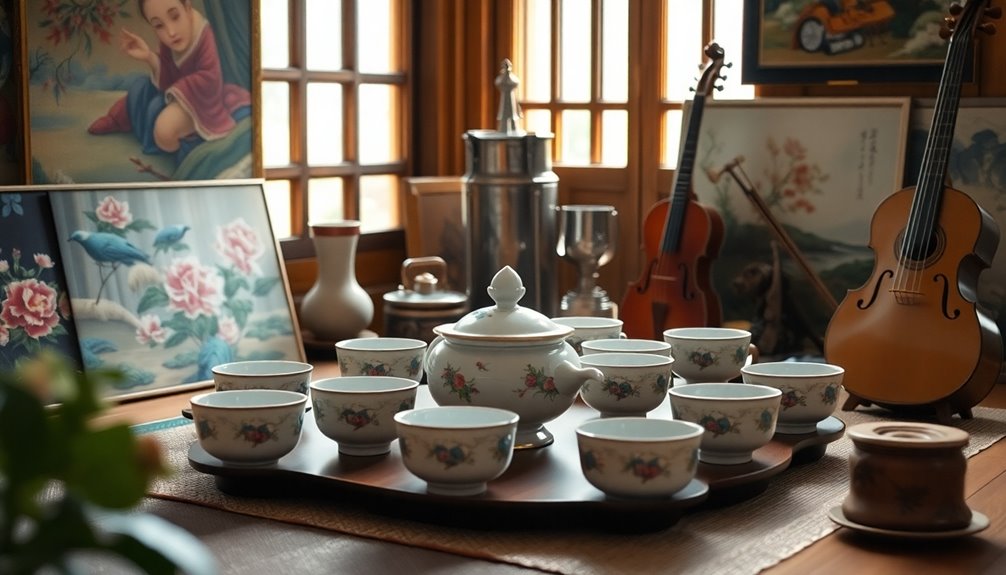
Artistic expression flourishes through the lens of tea, revealing its profound influence on various creative forms. You might be surprised to learn how tea drinking and brewing tea inspire artists across many fields.
For instance, Mary Cassatt's paintings from the 19th century beautifully portray tea parties, showcasing the social elegance of tea rituals. In many Asian cultures, the act of brewing tea itself is considered an art form, where each technique reflects the brewer's creativity.
Innovative artists have even transformed tea leaves into unique artworks. They use tea stains and leaves to create stunning watercolor paintings, making each piece a tribute to tea's beauty.
In literature, tea holds a special place too. Elegant tea ceremonies appear in Japanese stories, symbolizing refinement and contemplation in classic novels.
Moreover, the culinary arts celebrate tea's versatility. You'll find delicious creations like green tea ice cream and Earl Grey chocolates that elevate tea beyond just a drink.
These examples show how tea not only fills cups but also enriches our cultural landscape, inspiring creativity and connection in artistic expression.
Tea in Musical Compositions
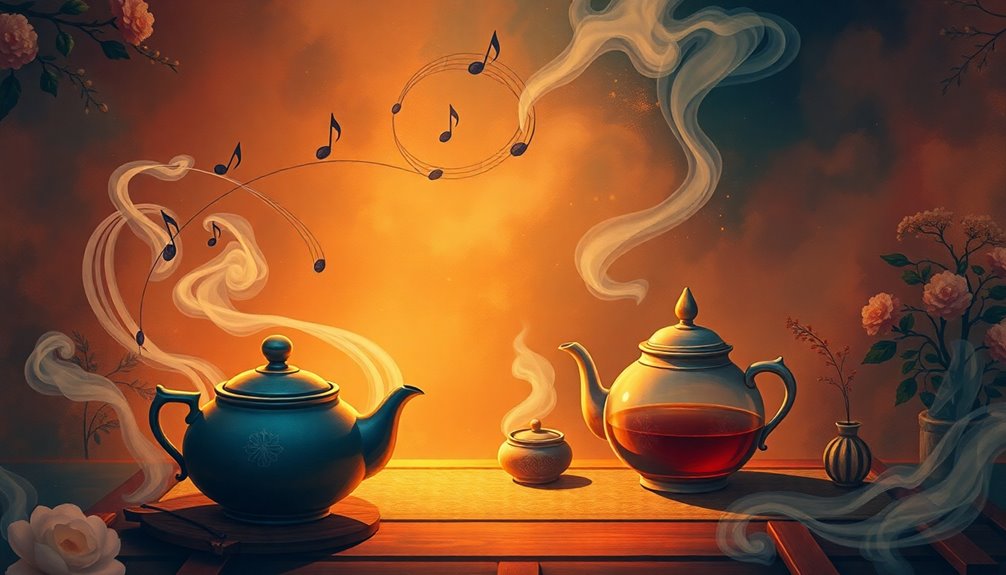
The creative spirit inspired by tea extends beyond visual arts and into the realm of music.
You'll find numerous compositions that celebrate tea's warmth and social connections. For instance, the catchy tune "Tea for Two" by Vincent Youmans has become a jazz standard, showing how tea can inspire lively conversations.
In classical music, composer Antonín Dvořák weaves tea culture into his "Slavonic Dances," illustrating the communal rituals of tea drinking in Eastern Europe.
Japanese tea ceremonies have also influenced contemporary composers like Toru Takemitsu, who captures the mindfulness and beauty of these rituals in his music.
Opera lovers can enjoy tea's role in social interactions, especially in Giacomo Puccini's "La Bohème," where characters sip tea while sharing their dreams and stories.
Folk traditions also celebrate tea in songs that tell tales of community gatherings and shared experiences, reinforcing tea's cultural significance.
Whether you're sipping a cup of tea or listening to music that celebrates it, you'll discover that tea plays a vital role in connecting people through art and melody, showcasing the rich tapestry of our shared experiences.
Cultural Appropriation in Tea Art
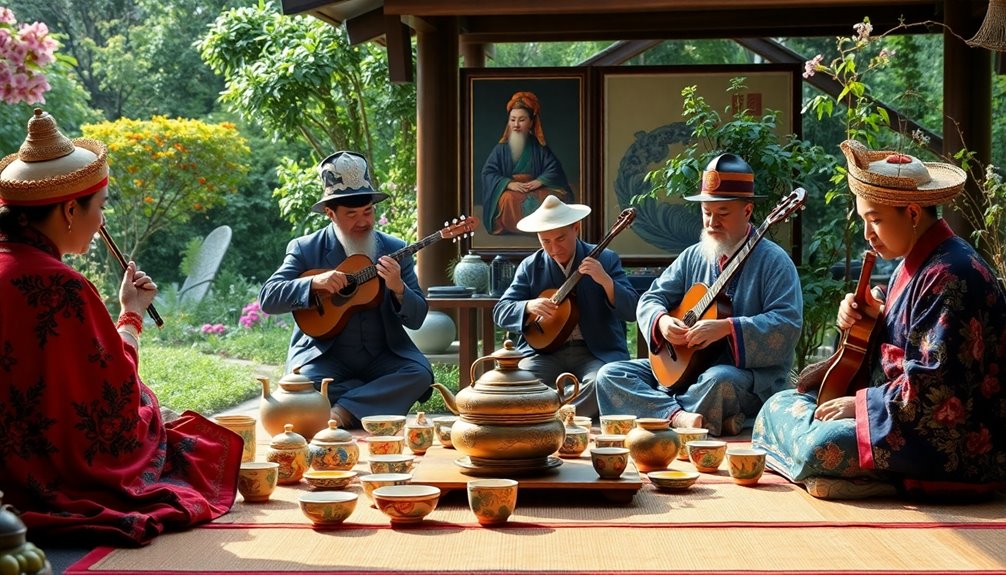
In exploring tea art, it's essential to recognize how cultural appropriation can distort the rich heritage behind these practices. When artists from outside the cultures that created tea ceremonies adopt these traditions without understanding their meaning, it can lead to significant misunderstandings.
For example, in Western contexts, misrepresentation of tea ceremonies often overshadows the beautiful philosophies found in Asian traditions, like the Japanese tea ceremony.
Additionally, the commercialization of tea art can dilute traditional methods. You might notice mass-produced teapots and accessories that simply don't match the craftsmanship of authentic artisan creations. This can make it hard for people to appreciate the original cultural significance.
To truly honor these traditions, you should engage with tea art in a way that respects its origins. This means learning about the cultures behind tea and appreciating the unique practices they offer.
Efforts to promote authentic tea art help celebrate and preserve these traditions, resisting the urge to commodify or appropriate them. By being sensitive and aware, you can enjoy tea art while honoring its beautiful heritage.
Practical Applications
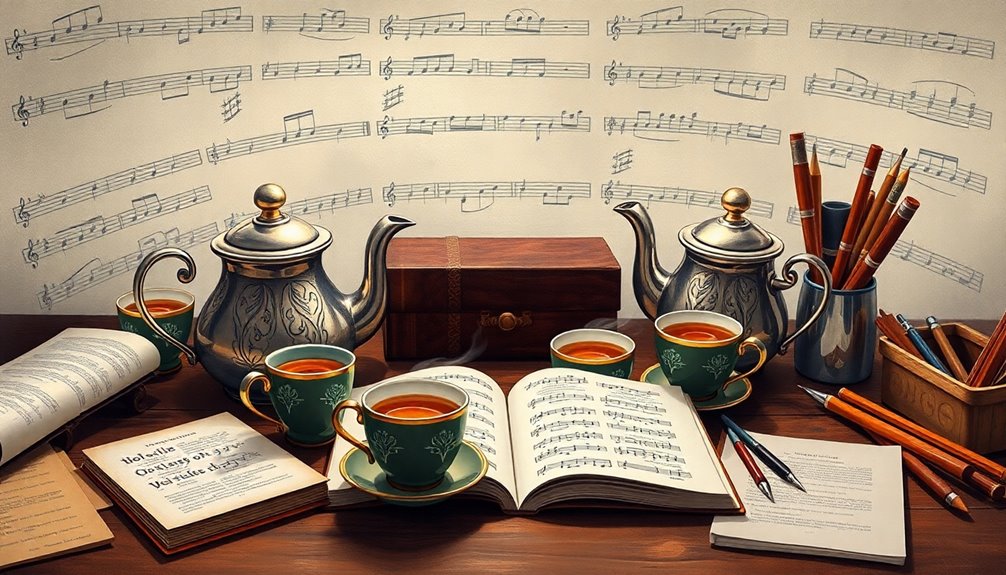
There's a world of possibilities when it comes to incorporating tea into your daily life beyond just sipping it from a cup. You can start by using tea in your cooking adventures. Try making green tea ice cream or Earl Grey-infused desserts to add unique flavors to your meals.
Another fun idea is tea pairing, much like wine pairing. Learn how different types of tea can complement various foods to elevate your dining experiences. Imagine sipping a delicate jasmine tea alongside a light salad!
If you're feeling artistic, consider using tea leaves and stains to create beautiful paintings. This blend of visual art and tea culture lets you express yourself in a unique way.
For those who enjoy reading, dive into classic novels and poems where tea often symbolizes refinement and contemplation.
Lastly, why not host a tea ceremony or themed tea party? These events celebrate the rituals and artistry of tea, deepening your appreciation for its rich cultural significance.
Frequently Asked Questions
What Is the Cultural Significance of Tea?
Tea's cultural significance lies in its ability to foster connections, symbolize rituals, and enhance social interactions. It's a bridge between traditions, promoting mindfulness and appreciation of nature, while also reflecting class distinctions and societal norms.
Why Is Art Literature and Music an Important Part of Culture?
Art, literature, and music shape your cultural identity, expressing shared values and emotions. They foster understanding and empathy, helping you connect with others while preserving traditions, enriching your experiences, and stimulating your creativity and critical thinking.
How Did Tea Impact Other Society?
Tea's influenced societies by fostering social interactions, shaping customs, and elevating gatherings. You see its impact in various cultures, from Turkey's çai rituals to Britain's historical connections, enriching community bonds and social dynamics globally.
Where Did the Art of Tea Come From?
The art of tea originated in China during the Ming Dynasty. You'll find its roots in the practice of steeping leaves, which evolved from earlier methods, influencing cultures worldwide and shaping unique tea traditions everywhere.
Conclusion
In conclusion, tea isn't just a drink; it's a cultural treasure that inspires art, music, and literature all around the world. By exploring its rich history and significance, you can appreciate the beauty it brings to creativity. So, why not brew a cup and let your imagination flow? Whether you're painting, writing, or listening to music, let tea be your muse. Embrace its warmth and see how it can spark your own artistic journey!

